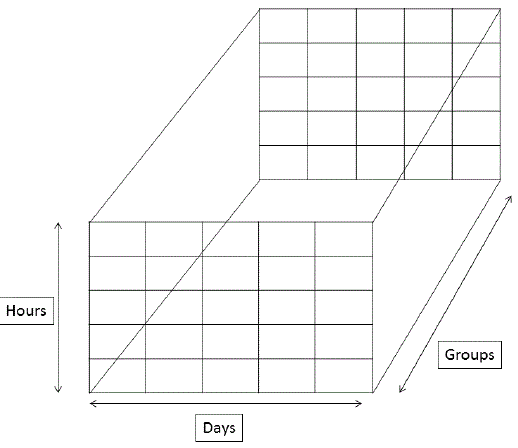Class Schedule Assignment Based on Students Learning Rhythms Using A Genetic Algorithm
Main Article Content
Keywords
learning rhythms, genetic algorithm, class schedule, optimization, logistic.
Abstract
The objective of this proposal is to implement a school day agenda focused on the learning rhythms of students of elementary and secondary schools using a genetic algorithm. The methodology of this proposal takes into account legal requirements and constraints on the assignment of teachers and classrooms in public educational institutions in Colombia. In addition, this proposal provides a set of constraints focused on cognitive rhythms and subjects are scheduled at the most convenient times according to the area of knowledge. The genetic algorithm evolves through a process of mutation and selection and builds a total solution based on the best solutions for each group. Sixteen groups in a school are tested and the results of class schedule assignments are presented. The quality of the solution obtained through the established approach is validated by comparing the results to the solutions obtained using another algorithm.
MSC: 49-00, 90B06
Downloads
References
[2] D. DeWerra, “An introduction to timetabling,” European Journal of Operational Research, vol. 19, pp. 151–162, 1985. 80
[3] S. Daskalaki, T. Birbas, and E. Housos, “An integer programming formulation for a case study in university timetabling,” European Journal of Operational Research, vol. 153, no. 1, pp. 117–135, 2004. [Online]. Available: http://www.sciencedirect.com/science/article/pii/S0377221703001036 80
[4] S. Daskalaki and T. Birbas, “Efficient solutions for a university timetabling problem through integer programming,” European Journal of Operational Research, vol. 160, no. 1, pp. 106–120, 2005. [Online]. Available: http://www.sciencedirect.com/science/article/pii/S0377221703005046 80
[5] N. Boland, B. D. Hughes, L. T. G. Merlot, and P. J. Stuckey, “New integer linear programming approaches for course timetabling,” Computers & Operations Research, vol. 35, no. 7, pp. 2209–2233, 2008. [Online]. Available:
http://www.sciencedirect.com/science/article/pii/S0305054806002784 80
[6] J. Patterson, F. Brian Talbot, R. Slowinski, and J. Weglarz, “Computational experience with a backtracking algorithm for solving a general class of precedence and resource-constrained scheduling problems,” EuropeanJournal of Operational Research, vol. 49, pp. 68–79, 1990. 80
[7] N. Sadeh, K. Sycara, and Y. Xiong, “Backtracking techniques for the job shop scheduling constraint satisfaction problem,” Artificial Intelligence, vol. 76, no. 1–2, pp. 455–480, 1995. [Online]. Available: http://www.sciencedirect.com/science/article/pii/000437029500078S 80
[8] E. K. Burke and S. Petrovic, “Recent Research Directions in Automated Timetabling,” European Journal of Operational Research, vol. 140, pp. 266–280, 2002. 80
[9] M. Granada, E. Toro Ocampo, and J. Baquero Franco, “Programación óptima de horarios de clase usando un algoritmo memético,” Scientia et Technica, vol. 1, no. 30, 2006. [Online]. Available:
http://revistas.utp.edu.co/index.php/revistaciencia/article/view/6531 80
[10] N. Pillay and W. Banzhaf, “An informed genetic algorithm for the examination timetabling problem,” Applied Soft Computing, vol. 10, no. 2, pp. 457–467, 2010. [Online]. Available: http://www.sciencedirect.com/science/article/pii/
S1568494609001331 80
[11] J. M. Mejía Caballero and C. Paternina Arboleda, “Asignación de horarios de clases universitarias mediante algoritmos evolutivos,” Educación en Ingeniería, no. 9, pp. 140–149, 2010. 80
[12] P. D. Causmaecker, P. Demeester, and G. V. Berghe, “A decomposed metaheuristic approach for a real-world university timetabling problem,” European Journal of Operational Research, vol. 195, no. 1, pp. 307–318, 2009. [Online]. Available: http://www.sciencedirect.com/science/article/pii/S0377221708001665 80
[13] J. Studenovský, “Polynomial reduction of timeâ“space scheduling to time scheduling,” Discrete Applied Mathematics, vol. 157, no. 7, pp. 1364–1378, 2009. [Online]. Available: http://www.sciencedirect.com/science/article/pii/S0166218X08004708 80
[14] Z. Lü and J.-K. Hao, “Adaptive Tabu Search for course timetabling,” European Journal of Operational Research, vol. 200, no. 1, pp. 235–244, 2010. [Online]. Available: http://www.sciencedirect.com/science/article/pii/
S0377221708010394 80
[15] C.-C. Wu, “Parallelizing a CLIPS-based course timetabling expert system,” Expert Systems with Applications, vol. 38, no. 6, pp. 7517–7525, 2011. [Online]. Available: http://www.sciencedirect.com/science/article/pii/ S095741741001479X 80
[16] H. Turabieh and S. Abdullah, “An integrated hybrid approach to the examination timetabling problem,” Omega, vol. 39, no. 6, pp. 598–607, 2011. [Online]. Available: http://www.sciencedirect.com/science/article/pii/
S030504831100003X 80
[17] C. Soza, R. L. Becerra, M. C. Riff, and C. A. C. Coello, “Solving timetabling problems using a cultural algorithm,” Applied Soft Computing, vol. 11, no. 1, pp. 337–344, 2011. [Online]. Available: http://www.sciencedirect.com/science/article/pii/S1568494609002373 80
[18] J.-K. Hao and U. Benlic, “Lower bounds for the ITC-2007 curriculumbased course timetabling problem,” European Journal of Operational Research, vol. 212, no. 3, pp. 464–472, 2011. [Online]. Available:
http://www.sciencedirect.com/science/article/pii/S0377221711001500 80
[19] R. Feito Alonso, “Tiempos escolares: El debate sobre la jornada escolar continua y partida,” Cuadernos de pedagogía, vol. 365, 2007. 80
[20] Banco Mundial., La calidad de la educación en Colombia: Un análisis y algunas opciones para un programa de política. Bogotá: Banco Internacional de Reconstrucción y Fomento / Banco Mundial Misión residente en Colombia, 2009. 80
[21] A. Colorni, M. Dorigo, and V. Maniezzo, “A Genetic Algorithm To Solve The Timetable Problem,” 1993. [Online]. Available: http://citeseerx.ist.psu.edu/viewdoc/summary?doi=10.1.1.49.3342 81
[22] W. Erben and J. Keppler, “A genetic algorithm solving a weekly coursetimetabling problem,” in Practice and Theory of Automated Timetabling, ser. Lecture Notes in Computer Science, E. Burke and P. Ross, Eds. Springer Berlin Heidelberg, 1996, vol. 1153, pp. 198–211. [Online]. Available: http://dx.doi.org/10.1007/3-540-61794-9_60 81
[23] P. Mendoza Crisostomo, I. Flores Trujillo, and D. Morales Genis, “Algoritmo Evolutivo para generar cargas académicas en TIC-SI,” in 4to Simposio Internacional en Sistemas Inteligentes y Organizaciones Inteligentes, México D.F., 2009. 81
[24] V. F. Suárez, A. Guerrero, and O. D. Castrillón, “Programación de Horarios Escolares basados en Ritmos Cognitivos usando un Algoritmo Genético de Clasificación No-dominada, NSGA-II,” Inf. tecnol., vol. 24, no. 1, pp. 103–114, 2013. 81, 82, 86
[25] G. Beligiannis and S. Moschopoulos, C Likothanassis, “A genetic algorithm approach to school timetabling,” Journal of the Operational Research Society, vol. 60, pp. 23–42, 2009. 82
[26] G. Peñalara, “Generador de horarios para centros de enseñanza,” 2008. [Online]. Available: http://www.penalara.com/ 88

